英语课堂教学设计论文
小学英语教学论文(精选五篇)
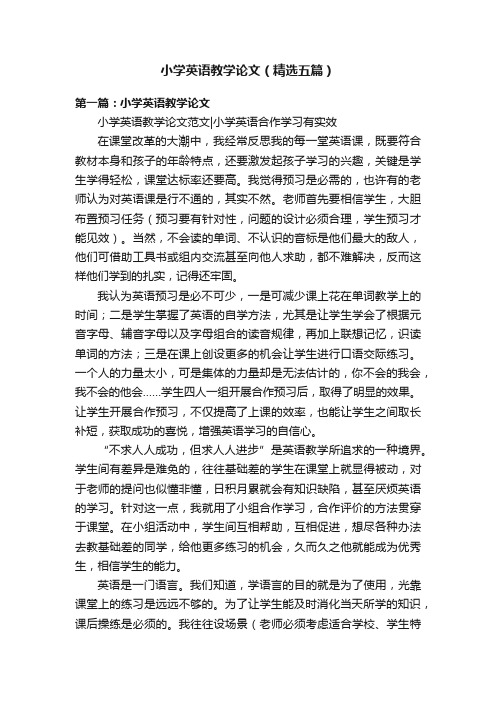
小学英语教学论文(精选五篇)第一篇:小学英语教学论文小学英语教学论文范文|小学英语合作学习有实效在课堂改革的大潮中,我经常反思我的每一堂英语课,既要符合教材本身和孩子的年龄特点,还要激发起孩子学习的兴趣,关键是学生学得轻松,课堂达标率还要高。
我觉得预习是必需的,也许有的老师认为对英语课是行不通的,其实不然。
老师首先要相信学生,大胆布置预习任务(预习要有针对性,问题的设计必须合理,学生预习才能见效)。
当然,不会读的单词、不认识的音标是他们最大的敌人,他们可借助工具书或组内交流甚至向他人求助,都不难解决,反而这样他们学到的扎实,记得还牢固。
我认为英语预习是必不可少,一是可减少课上花在单词教学上的时间;二是学生掌握了英语的自学方法,尤其是让学生学会了根据元音字母、辅音字母以及字母组合的读音规律,再加上联想记忆,识读单词的方法;三是在课上创设更多的机会让学生进行口语交际练习。
一个人的力量太小,可是集体的力量却是无法估计的,你不会的我会,我不会的他会……学生四人一组开展合作预习后,取得了明显的效果。
让学生开展合作预习,不仅提高了上课的效率,也能让学生之间取长补短,获取成功的喜悦,增强英语学习的自信心。
“不求人人成功,但求人人进步”是英语教学所追求的一种境界。
学生间有差异是难免的,往往基础差的学生在课堂上就显得被动,对于老师的提问也似懂非懂,日积月累就会有知识缺陷,甚至厌烦英语的学习。
针对这一点,我就用了小组合作学习,合作评价的方法贯穿于课堂。
在小组活动中,学生间互相帮助,互相促进,想尽各种办法去教基础差的同学,给他更多练习的机会,久而久之他就能成为优秀生,相信学生的能力。
英语是一门语言。
我们知道,学语言的目的就是为了使用,光靠课堂上的练习是远远不够的。
为了让学生能及时消化当天所学的知识,课后操练是必须的。
我往往设场景(老师必须考虑适合学校、学生特点的场景)让他们课后合作操练,这不需要花很多时间,学生也很愿意学习。
中学英语课程教学论文七篇

中学英语课程教学论文七篇【篇一】摘要:修订的课程标准中提出“核心素养”理念,其中的学习能力包涵了合作学习能力。
本文通过一个课例的教学步骤来探讨合作学习在英语教学中的应用,以便让学生在合作学习中提高学习效率,让英语教学达到育人的效果。
关键词:合作学习,课例,效果一、合作学习的理论基础合作学习指学生自主学习,探究为基础,在学生合作互动,互帮互助下完成学习任务。
合作学习可以分为小组合作预习与讨论策略,共同合作模式策略和小组互相交流与协作策略【1】。
合作学习是英语教学中有效的教学方式,小组合作学习的课堂教学主要包括以下几个步骤:第一、确定本节的教学目标,根据目标设计对应的教学活动。
第二、以问题导学为基础,进行小组合作预习与讨论。
第三、组内合作与组组交流或竞赛,对其他各组进行补充或解答。
第四、老师进行客观,全面的评价。
二、合作学习实施的教学过程下面以人教版英语选修六第四单元中的第三节whatwedoaboutglobalwarming为例详细谈谈合作学习的实施情况。
这节课的话题是人类当今面对的全球变暖问题,主要探讨了如何节约能源方面的问题。
教学内容分为三部分:第一部分是利用五幅图片和一个短视屏,引入话题。
引导学生进行听说训练。
第二部分是阅读两封信,涉及如何节约能源。
第三部分是在前面阅读理解所学知识为基础,利用竞赛形式让学生分享如何节约能源,然后整理成一篇海报或作文。
具体教学过程如下:三、合作学习在本节课的成效反思并总结本节课的教学,本节课中学生始终处于学习的主体地位,是课堂的主人,通过合作学习,讨论,竞赛,让学生在互动中完成学习任务,获得进步,达到效果。
合作学习体现在以下几个方面:首先,整个教学以任务为基础,第一环节中,让学生讨论与全球变暖有关的图片,并描述图片内容,讨论之后,让小组各派一个代表上台展示,这样能激发学生的学习兴趣和动力,接着问whatarethecausesofsuchphenomena?引出全球变暖的话题。
英语高效课堂论文5篇精编
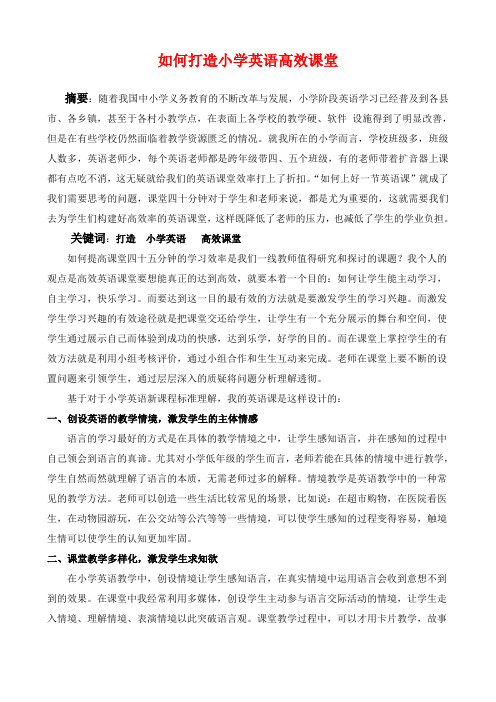
如何打造小学英语高效课堂摘要:随着我国中小学义务教育的不断改革与发展,小学阶段英语学习已经普及到各县市、各乡镇,甚至于各村小教学点,在表面上各学校的教学硬、软件设施得到了明显改善,但是在有些学校仍然面临着教学资源匮乏的情况。
就我所在的小学而言,学校班级多,班级人数多,英语老师少,每个英语老师都是跨年级带四、五个班级,有的老师带着扩音器上课都有点吃不消,这无疑就给我们的英语课堂效率打上了折扣。
“如何上好一节英语课”就成了我们需要思考的问题,课堂四十分钟对于学生和老师来说,都是尤为重要的,这就需要我们去为学生们构建好高效率的英语课堂,这样既降低了老师的压力,也减低了学生的学业负担。
关键词:打造小学英语高效课堂如何提高课堂四十五分钟的学习效率是我们一线教师值得研究和探讨的课题?我个人的观点是高效英语课堂要想能真正的达到高效,就要本着一个目的:如何让学生能主动学习,自主学习,快乐学习。
而要达到这一目的最有效的方法就是要激发学生的学习兴趣。
而激发学生学习兴趣的有效途径就是把课堂交还给学生,让学生有一个充分展示的舞台和空间,使学生通过展示自己而体验到成功的快感,达到乐学,好学的目的。
而在课堂上掌控学生的有效方法就是利用小组考核评价,通过小组合作和生生互动来完成。
老师在课堂上要不断的设置问题来引领学生,通过层层深入的质疑将问题分析理解透彻。
基于对于小学英语新课程标准理解,我的英语课是这样设计的:一、创设英语的教学情境,激发学生的主体情感语言的学习最好的方式是在具体的教学情境之中,让学生感知语言,并在感知的过程中自己领会到语言的真谛。
尤其对小学低年级的学生而言,老师若能在具体的情境中进行教学,学生自然而然就理解了语言的本质,无需老师过多的解释。
情境教学是英语教学中的一种常见的教学方法。
老师可以创造一些生活比较常见的场景,比如说:在超市购物,在医院看医生,在动物园游玩,在公交站等公汽等等一些情境,可以使学生感知的过程变得容易,触境生情可以使学生的认知更加牢固。
初中英语教学优秀论文3篇

初中英语教学优秀论文3篇
论文1:提高初中英语教学质量的有效策略
这篇论文探讨了提高初中英语教学质量的有效策略。
作者首先分析了初中英语教学存在的问题,如学生研究动力不足、教材内容单一等。
接着,作者提出了一些行之有效的策略,包括鼓励互动式研究、提供个性化辅导等。
最后,作者通过实践案例证明了这些策略的有效性。
论文2:提高初中英语口语能力的教学方法研究
本文旨在研究提高初中学生英语口语能力的教学方法。
作者通过对现有教学方法的分析和评估,提出了一种以情景教学为基础的方法。
该方法通过创造真实的语境,促使学生主动参与口语表达。
实证研究表明,该方法可以有效提高学生的口语能力。
论文3:初中英语课堂互动教学的实施策略
这篇论文介绍了初中英语课堂互动教学的实施策略。
作者提出了一套可行的策略,包括采用小组活动、引入多媒体资源等。
通过实际教学案例的分析,作者证明了这些策略能够激发学生的研究兴趣,提高课堂互动效果。
以上是三篇关于初中英语教学的优秀论文的简要介绍,希望对您有所帮助。
如需详细内容,请查阅相关文献。
英语教学论文范文(精选6篇)(4)
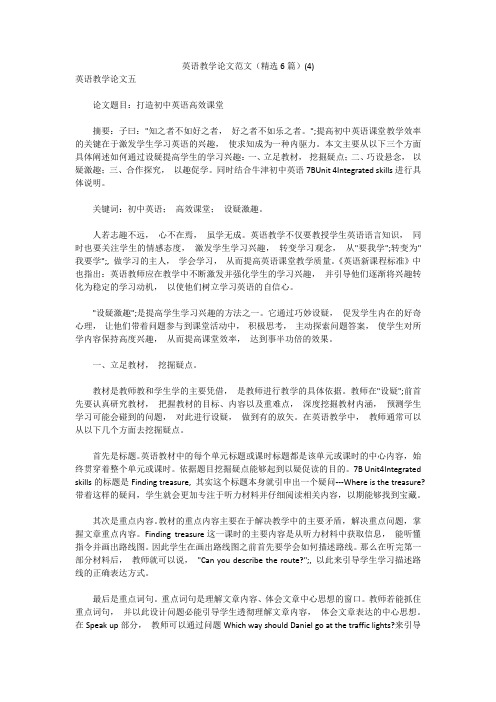
英语教学论文范文(精选6篇)(4)英语教学论文五论文题目:打造初中英语高效课堂摘要:子曰:"知之者不如好之者,好之者不如乐之者。
";提高初中英语课堂教学效率的关键在于激发学生学习英语的兴趣,使求知成为一种内驱力。
本文主要从以下三个方面具体阐述如何通过设疑提高学生的学习兴趣:一、立足教材,挖掘疑点;二、巧设悬念,以疑激趣;三、合作探究,以趣促学。
同时结合牛津初中英语7BUnit 4Integrated skills进行具体说明。
关键词:初中英语;高效课堂;设疑激趣。
人若志趣不远,心不在焉,虽学无成。
英语教学不仅要教授学生英语语言知识,同时也要关注学生的情感态度,激发学生学习兴趣,转变学习观念,从"要我学";转变为"我要学";, 做学习的主人,学会学习,从而提高英语课堂教学质量。
《英语新课程标准》中也指出:英语教师应在教学中不断激发并强化学生的学习兴趣,并引导他们逐渐将兴趣转化为稳定的学习动机,以使他们树立学习英语的自信心。
"设疑激趣";是提高学生学习兴趣的方法之一。
它通过巧妙设疑,促发学生内在的好奇心理,让他们带着问题参与到课堂活动中,积极思考,主动探索问题答案,使学生对所学内容保持高度兴趣,从而提高课堂效率,达到事半功倍的效果。
一、立足教材,挖掘疑点。
教材是教师教和学生学的主要凭借,是教师进行教学的具体依据。
教师在"设疑";前首先要认真研究教材,把握教材的目标、内容以及重难点,深度挖掘教材内涵,预测学生学习可能会碰到的问题,对此进行设疑,做到有的放矢。
在英语教学中,教师通常可以从以下几个方面去挖掘疑点。
首先是标题。
英语教材中的每个单元标题或课时标题都是该单元或课时的中心内容,始终贯穿着整个单元或课时。
依据题目挖掘疑点能够起到以疑促读的目的。
7B Unit4Integrated skills的标题是Finding treasure, 其实这个标题本身就引申出一个疑问---Where is the treasure?带着这样的疑问,学生就会更加专注于听力材料并仔细阅读相关内容,以期能够找到宝藏。
英语教学论文10篇
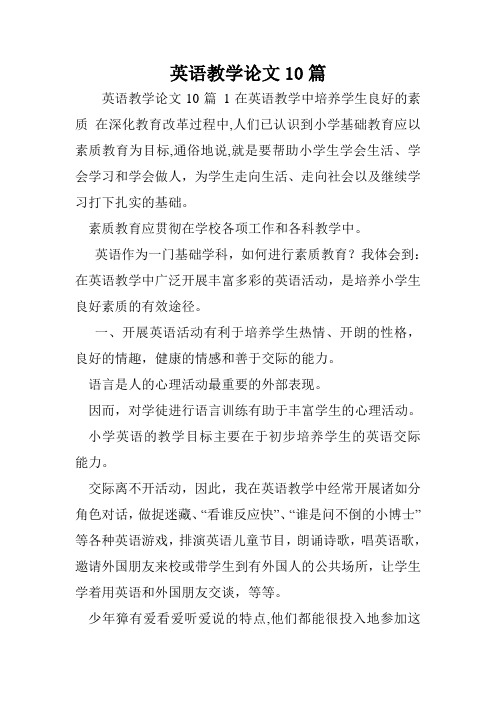
英语教学论文10篇英语教学论文10篇1在英语教学中培养学生良好的素质在深化教育改革过程中,人们已认识到小学基础教育应以素质教育为目标,通俗地说,就是要帮助小学生学会生活、学会学习和学会做人,为学生走向生活、走向社会以及继续学习打下扎实的基础。
素质教育应贯彻在学校各项工作和各科教学中。
英语作为一门基础学科,如何进行素质教育?我体会到:在英语教学中广泛开展丰富多彩的英语活动,是培养小学生良好素质的有效途径。
一、开展英语活动有利于培养学生热情、开朗的性格,良好的情趣,健康的情感和善于交际的能力。
语言是人的心理活动最重要的外部表现。
因而,对学徒进行语言训练有助于丰富学生的心理活动。
小学英语的教学目标主要在于初步培养学生的英语交际能力。
交际离不开活动,因此,我在英语教学中经常开展诸如分角色对话,做捉迷藏、“看谁反应快”、“谁是问不倒的小博士”等各种英语游戏,排演英语儿童节目,朗诵诗歌,唱英语歌,邀请外国朋友来校或带学生到有外国人的公共场所,让学生学着用英语和外国朋友交谈,等等。
少年獐有爱看爱听爱说的特点,他们都能很投入地参加这此有趣的英语活动。
去年五月,我邀请了英国的希尔夫妇来校和学生联欢。
同学们有礼貌地用“Welcome to China! ““Welcome to our school!“等情真意切的语言欢迎他们。
听他们介绍了情况后,同学们热切地向他们提了许多问题:“Do you like China?“ “How many people are there in your family?“希尔夫妇在回答问题后,也向同学们提了一些问题.同学们争先恐后举手,清楚流利地一一作答.同学们还三两人一组主动地走到客人面前,先自我介绍: “My name is Wang Xi. My English name is Mike.“然后介绍自己的同学: “This is Xing Li“两人一起说:“We are classmates.“然后拉着客人的手:“Nice to meet you!“再问:“Could we be friends?““Good!“ “Well done!“希尔夫妇连声赞叹道.最后同学们热情洋溢地献上自己制作的小手工、小作品,或是小工艺品,•还没忘记再说上几句英语:“Do you like it?““Welcome again!“同学们惊喜地发现:外国人讲话我们大部分能听懂,我们讲的他们也能听懂,真有趣.学生亲身参加活动能帮助他们克服畏难情绪,激发主动积极的学习精神.有些原来性格腼腆、站起来说话就脸红心跳的学生,通过以上英语活动的锻炼,已能经常自告奋勇地出来对话、表演了。
英语课堂教学论文两篇
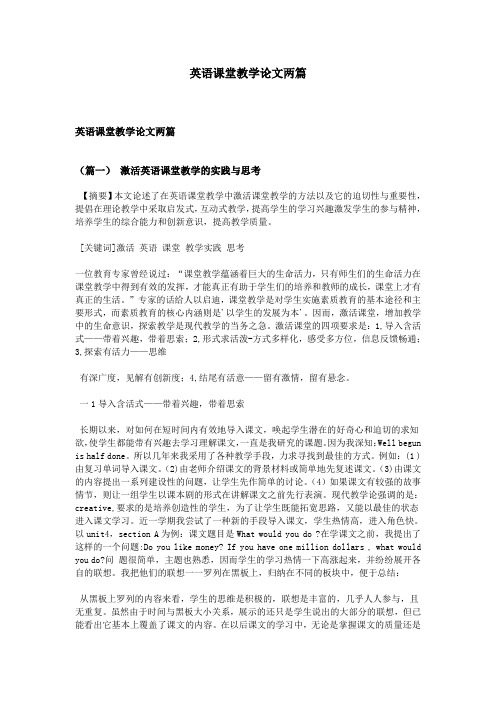
英语课堂教学论文两篇英语课堂教学论文两篇(篇一)激活英语课堂教学的实践与思考【摘要】本文论述了在英语课堂教学中激活课堂教学的方法以及它的迫切性与重要性,提倡在理论教学中采取启发式,互动式教学,提高学生的学习兴趣激发学生的参与精神,培养学生的综合能力和创新意识,提高教学质量。
[关键词]激活英语课堂教学实践思考一位教育专家曾经说过:“课堂教学蕴涵着巨大的生命活力,只有师生们的生命活力在课堂教学中得到有效的发挥,才能真正有助于学生们的培养和教师的成长,课堂上才有真正的生活。
”专家的话给人以启迪,课堂教学是对学生实施素质教育的基本途径和主要形式,而素质教育的核心内涵则是'以学生的发展为本'。
因而,激活课堂,增加教学中的生命意识,探索教学是现代教学的当务之急。
激活课堂的四项要求是:1,导入含活式——带着兴趣,带着思索;2,形式求活泼-方式多样化,感受多方位,信息反馈畅通;3,探索有活力——思维有深广度,见解有创新度;4,结尾有活意——留有激情,留有悬念。
一1导入含活式——带着兴趣,带着思索长期以来,对如何在短时间内有效地导入课文,唤起学生潜在的好奇心和迫切的求知欲,使学生都能带有兴趣去学习理解课文,一直是我研究的课题。
因为我深知:Well begun is half done。
所以几年来我采用了各种教学手段,力求寻找到最佳的方式。
例如:(1 ) 由复习单词导入课文。
(2)由老师介绍课文的背景材料或简单地先复述课文。
(3)由课文的内容提出一系列建设性的问题,让学生先作简单的讨论。
(4)如果课文有较强的故事情节,则让一组学生以课本剧的形式在讲解课文之前先行表演。
现代教学论强调的是:creative,要求的是培养创造性的学生,为了让学生既能拓宽思路,又能以最佳的状态进入课文学习。
近一学期我尝试了一种新的手段导入课文,学生热情高,进入角色快。
以unit4,section A为例:课文题目是What would you do ?在学课文之前,我提出了这样的一个问题:Do you like money? If you have one million dollars , what would you do?问题很简单,主题也熟悉,因而学生的学习热情一下高涨起来,并纷纷展开各自的联想。
英语教学方法论文(优秀6篇)
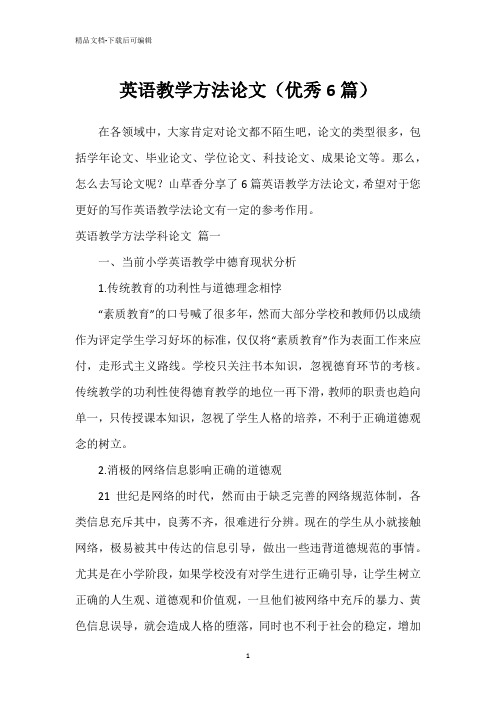
英语教学方法论文(优秀6篇)在各领域中,大家肯定对论文都不陌生吧,论文的类型很多,包括学年论文、毕业论文、学位论文、科技论文、成果论文等。
那么,怎么去写论文呢?山草香分享了6篇英语教学方法论文,希望对于您更好的写作英语教学法论文有一定的参考作用。
英语教学方法学科论文篇一一、当前小学英语教学中德育现状分析1.传统教育的功利性与道德理念相悖“素质教育”的口号喊了很多年,然而大部分学校和教师仍以成绩作为评定学生学习好坏的标准,仅仅将“素质教育”作为表面工作来应付,走形式主义路线。
学校只关注书本知识,忽视德育环节的考核。
传统教学的功利性使得德育教学的地位一再下滑,教师的职责也趋向单一,只传授课本知识,忽视了学生人格的培养,不利于正确道德观念的树立。
2.消极的网络信息影响正确的道德观21世纪是网络的时代,然而由于缺乏完善的网络规范体制,各类信息充斥其中,良莠不齐,很难进行分辨。
现在的学生从小就接触网络,极易被其中传达的信息引导,做出一些违背道德规范的事情。
尤其是在小学阶段,如果学校没有对学生进行正确引导,让学生树立正确的人生观、道德观和价值观,一旦他们被网络中充斥的暴力、黄色信息误导,就会造成人格的堕落,同时也不利于社会的稳定,增加未成年人犯罪率。
因此,维护绿色网络,加强对学生正确使用互联网的引导,帮助学生树立强烈的网络文明意识是学校义不容辞的责任。
二、小学英语教学中德育理念渗透的途径1.创设适宜的教学情境英语作为外来文化的载体,教育学生学习优秀的国外文化知识,要将德育贯穿始终。
方法之一就是创设相应的情境,注重情感的渲染,让学生从主观上感受到德育的魅力,从而积极主动地接受德育教学。
课堂作为英语教学的主要阵地,教师要充分利用这一优势,根据课本内容创设适宜的情境,激发学生的参与热情,让学生在互动中形成正确的道德观念。
例如,在学习餐厅礼仪时,教师可以将课堂布置成类似于餐厅的样子,随机挑选学生扮演顾客和服务员,教导学生学会运用敬语询问顾客的需求,如“WhatcanIdoforyou?”同时顾客也要礼貌地回答问题,同时表达对服务的感谢,以“Thankyou.”作为结束语。
英语教学的论文

英语教学的论文有关英语教学的论文(精选12篇)在现实的学习、工作中,大家一定都接触过论文吧,论文是一种综合性的文体,通过论文可直接看出一个人的综合能力和专业基础。
那要怎么写好论文呢?以下是小编为大家整理的有关英语教学的论文(精选12篇),供大家参考借鉴,希望可以帮助到有需要的朋友。
英语教学的论文篇1“翻转课堂”(Flipped Class)是以学生自主学习为中心,师生互动学习的一种教学模式,它将微型化、个性化的微课资源有机整合成为我国信息化教学改革的新方向,设计“以学生为主体,微课为基础,课前自学与课上强化为主要形式”的翻转课堂模型。
那么,它在我们的英语教学中如何应用?下面我结合英语教学中比较难处理的阅读教学和语法教学来谈谈翻转课堂的应用。
一、在英语阅读教学中的应用(一)通过课前任务型个性化阅读培养学生自主学习能力课前教师让学生进行自主阅读,学生可以根据自己喜欢的阅读方式进行快乐阅读,让自主学习阅读变成“悦读”。
快乐阅读也应是有目的性的阅读,因此,教师可在课前下发任务单,如让学生根据所读的课文内容自主利用多媒体手段寻找与课文内容有关的视频资料等来辅助阅读内容的理解,自拟几个有关课文内容的问题等,这样既鼓励了学生对语言学习进行独立思考,又培养了学生自主学习的能力。
(二)课堂中开展针对性的阅读指导,让中下等生“吃得饱、消化好”,让优等生“吃得好、营养高”在翻转课堂中,学生已经在课前进行了阅读内容的学习,仍然以圣诞节课文为例,学生在进入课堂学习之前对圣诞节课文的大意已经有所了解,但不同的学生对阅读内容有着不同的疑难问题,因此在课堂中,教师可以通过回收课前下发的任务单并查看学生完成情况的方式发现并帮助学生解决个性化的问题,让中下等生“吃得饱、消化好”,让优等生“吃得好、营养高”,以此加快英语阅读教学课的进程,提升阅读效率。
(三)运用开放性、拓展性的问题机制激活学生个性化的思维,让课堂成为学生展示的主人翻转课堂中的英语阅读教学,首先课前已基本扫清了课文翻译障碍,课堂中教师不必将理解课文大意和知识点的讲解放在首位,所以课堂中的语言学习就应该聚焦于对文章话题的深度讨论和语言点的课外拓展。
英语教学论文范文(精选6篇)(4)

英语教学论文范文(精选6篇)(4)一、任务型教学法在初中英语课堂中的应用研究摘要:随着我国英语教学改革的不断深入,任务型教学法作为一种有效的教学方法,逐渐受到广大英语教师的关注。
本文以初中英语课堂为研究对象,探讨任务型教学法在实践中的应用及其成效。
1. 任务型教学法的概述任务型教学法(Taskbased Language Teaching,简称TBLT)是一种以任务为核心的教学模式,强调学生在完成任务的过程中自然习得语言。
这种教学法主张将语言学习与实际生活相结合,让学生在真实语境中运用英语,提高他们的语言运用能力。
2. 任务型教学法在初中英语课堂的应用实例案例一:《新目标英语》七年级上册Unit 7 “How much are these socks?”(1)任务设计:教师设计了一个“购物”任务,让学生在模拟的购物场景中运用本单元所学词汇和句型进行交流。
(2)任务实施:将学生分成若干小组,每组扮演不同的角色(顾客、售货员等)。
学生在完成任务的过程中,需要运用目标语言进行沟通,达成购物目标。
(3)任务评价:教师根据学生在任务过程中的表现,评价他们的语言运用能力、团队协作能力和问题解决能力。
3. 任务型教学法在初中英语课堂的应用成效(1)提高学生的英语学习兴趣:任务型教学法将课堂知识与实际生活相结合,使学生在轻松愉快的氛围中学习英语,增强了他们的学习兴趣。
(2)培养学生的语言运用能力:通过完成各种任务,学生将所学知识应用于实际情境,提高了他们的英语口语和听力水平。
(3)增进学生之间的合作与交流:任务型教学法强调团队合作,学生在完成任务的过程中,相互帮助、共同进步,增进了彼此间的友谊。
4. 结论任务型教学法在初中英语课堂中的应用具有显著成效,有助于提高学生的英语学习兴趣和语言运用能力。
教师在实际教学中,应根据学生的实际情况和教学内容,灵活设计任务,以充分发挥任务型教学法的优势。
二、任务型教学法在初中英语课堂中的应用策略1. 注重任务的真实性在设计任务时,教师应确保任务的真实性,使其贴近学生的生活实际。
英语课堂教学设计论文
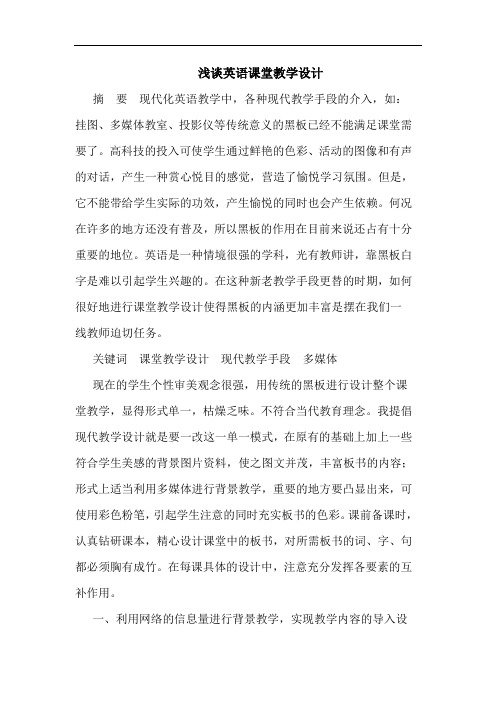
浅谈英语课堂教学设计摘要现代化英语教学中,各种现代教学手段的介入,如:挂图、多媒体教室、投影仪等传统意义的黑板已经不能满足课堂需要了。
高科技的投入可使学生通过鲜艳的色彩、活动的图像和有声的对话,产生一种赏心悦目的感觉,营造了愉悦学习氛围。
但是,它不能带给学生实际的功效,产生愉悦的同时也会产生依赖。
何况在许多的地方还没有普及,所以黑板的作用在目前来说还占有十分重要的地位。
英语是一种情境很强的学科,光有教师讲,靠黑板白字是难以引起学生兴趣的。
在这种新老教学手段更替的时期,如何很好地进行课堂教学设计使得黑板的内涵更加丰富是摆在我们一线教师迫切任务。
关键词课堂教学设计现代教学手段多媒体现在的学生个性审美观念很强,用传统的黑板进行设计整个课堂教学,显得形式单一,枯燥乏味。
不符合当代教育理念。
我提倡现代教学设计就是要一改这一单一模式,在原有的基础上加上一些符合学生美感的背景图片资料,使之图文并茂,丰富板书的内容;形式上适当利用多媒体进行背景教学,重要的地方要凸显出来,可使用彩色粉笔,引起学生注意的同时充实板书的色彩。
课前备课时,认真钻研课本,精心设计课堂中的板书,对所需板书的词、字、句都必须胸有成竹。
在每课具体的设计中,注意充分发挥各要素的互补作用。
一、利用网络的信息量进行背景教学,实现教学内容的导入设计比如在教学the green hills of tangsa一课时,教师可以放映一些紧扣教学的短片,诸如:why did the people along the changjiang river suffer a lot in the big flood in 1998?动物保护问题——the secret is out;关注地球问题——saving the earth;残疾人问题——feed the world;垃圾处理问题——dealing with waste 及自然灾害问题——earthquake, fire, hurricane 等让学生接受知识的同时增强责任感。
中小学英语教学论文六篇
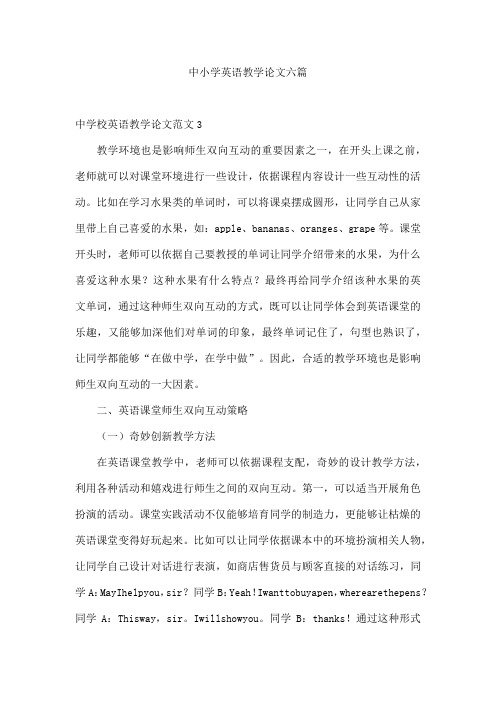
中小学英语教学论文六篇中学校英语教学论文范文3教学环境也是影响师生双向互动的重要因素之一,在开头上课之前,老师就可以对课堂环境进行一些设计,依据课程内容设计一些互动性的活动。
比如在学习水果类的单词时,可以将课桌摆成圆形,让同学自己从家里带上自己喜爱的水果,如:apple、bananas、oranges、grape等。
课堂开头时,老师可以依据自己要教授的单词让同学介绍带来的水果,为什么喜爱这种水果?这种水果有什么特点?最终再给同学介绍该种水果的英文单词,通过这种师生双向互动的方式,既可以让同学体会到英语课堂的乐趣,又能够加深他们对单词的印象,最终单词记住了,句型也熟识了,让同学都能够“在做中学,在学中做”。
因此,合适的教学环境也是影响师生双向互动的一大因素。
二、英语课堂师生双向互动策略(一)奇妙创新教学方法在英语课堂教学中,老师可以依据课程支配,奇妙的设计教学方法,利用各种活动和嬉戏进行师生之间的双向互动。
第一,可以适当开展角色扮演的活动。
课堂实践活动不仅能够培育同学的制造力,更能够让枯燥的英语课堂变得好玩起来。
比如可以让同学依据课本中的环境扮演相关人物,让同学自己设计对话进行表演,如商店售货员与顾客直接的对话练习,同学A:MayIhelpyou,sir?同学B:Yeah!Iwanttobuyapen,wherearethepens?同学A:Thisway,sir。
Iwillshowyou。
同学B:thanks!通过这种形式的练习不仅让同学感受到英语学习的乐趣,同时还能够增加他们对英语单词及语法的把握力量。
其次,老师可以在课堂中教同学一些简洁的英文歌曲,集中同学的留意力,让同学对英语预感的把握力量更加精确。
老师可以在每一堂课开头之前让同学唱一遍之前学习的英文歌,不仅能够达到活跃课堂气氛的目的,还能够关心同学了解和记忆更多的英文单词。
(二)合理运用多媒体教学随着多媒体技术的进展和教育理念的不断更新,多媒体帮助教学渐渐走进了中学,学校英语老师也可以借助这一先进教学工具,为英语课堂教学的双向互动增加新的推力。
英语教学论文范文(精选6篇)(4)
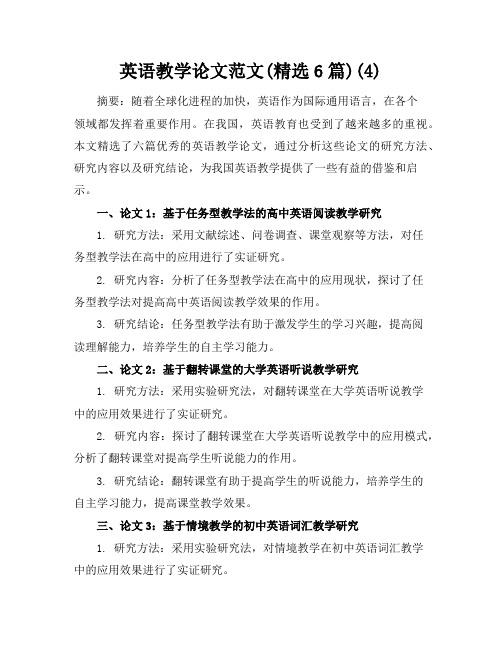
英语教学论文范文(精选6篇)(4)摘要:随着全球化进程的加快,英语作为国际通用语言,在各个领域都发挥着重要作用。
在我国,英语教育也受到了越来越多的重视。
本文精选了六篇优秀的英语教学论文,通过分析这些论文的研究方法、研究内容以及研究结论,为我国英语教学提供了一些有益的借鉴和启示。
一、论文1:基于任务型教学法的高中英语阅读教学研究1. 研究方法:采用文献综述、问卷调查、课堂观察等方法,对任务型教学法在高中的应用进行了实证研究。
2. 研究内容:分析了任务型教学法在高中的应用现状,探讨了任务型教学法对提高高中英语阅读教学效果的作用。
3. 研究结论:任务型教学法有助于激发学生的学习兴趣,提高阅读理解能力,培养学生的自主学习能力。
二、论文2:基于翻转课堂的大学英语听说教学研究1. 研究方法:采用实验研究法,对翻转课堂在大学英语听说教学中的应用效果进行了实证研究。
2. 研究内容:探讨了翻转课堂在大学英语听说教学中的应用模式,分析了翻转课堂对提高学生听说能力的作用。
3. 研究结论:翻转课堂有助于提高学生的听说能力,培养学生的自主学习能力,提高课堂教学效果。
三、论文3:基于情境教学的初中英语词汇教学研究1. 研究方法:采用实验研究法,对情境教学在初中英语词汇教学中的应用效果进行了实证研究。
2. 研究内容:探讨了情境教学在初中英语词汇教学中的应用模式,分析了情境教学对提高学生词汇掌握程度的作用。
3. 研究结论:情境教学有助于提高学生的词汇掌握程度,培养学生的语言运用能力,提高课堂教学效果。
四、论文4:基于项目式学习的大学英语写作教学研究1. 研究方法:采用实验研究法,对项目式学习在大学英语写作教学中的应用效果进行了实证研究。
2. 研究内容:探讨了项目式学习在大学英语写作教学中的应用模式,分析了项目式学习对提高学生写作能力的作用。
3. 研究结论:项目式学习有助于提高学生的写作能力,培养学生的创新思维和团队协作能力,提高课堂教学效果。
英语教学设计论文8篇

目前大学英语教学设计方式是以重学会,轻会学,重教材知识,轻生活世界为教学设计方式。
教学设计以知识为中心,强调学生对知识的掌握,以知识的传授为其突出特点,是知识本位的教学设计方式。
这种教学设计忽视了学生情感态度、个性特点等发展,对学生的全面发展造成很大的障碍,使学生成为学习知识的工具。
事实上,学生学习知识本是为了学生自身的发展与进步,而知识本位的教学设计却将知识本身当作了教学目的,成了为学习知识而学习知识。
随着人们认识水平的提高,教学设计理论的发展以及知识本位教学设计的弊端不断显现,传统英语教学设计应走出知识本位的误区,这已成为教育理论界和实践界的共识。
教学设计主要包括教学目标、教学过程、教学评价等方面。
该文主要从这三方面探讨。
1.1教学目标设计中存在的问题(1)目标设计缺乏实际应用性现阶段我国高校教师在英语教学目标的设计过程中,通常存在一些问题,在教学目标设计上,教师在课堂上过多注重语法、词汇、句型等教材内容的讲解,缺少对学生实际应用英语的能力培养。
教师大都采用翻译教学法为学生授课,学生学习的主体性不能得到真正地发挥,学生发现问题、解决问题的能力较差。
(2)目标设计与测试相结合1.2教学过程设计现状当今在我国高校英语教育教学过程中,英语教师在教学过程的设计上主要是以教师讲授教材内容为主,极少涉及适合学生特点的,与学生生活背景及就业密切相关的实用知识的内容。
学生用了大部分时间在学校学习基本知识,但学习及应用效果却大打折扣。
这种原有的英语教学设计模式不能满足我国应用型大学英语教育发展的实际要求,与时代的发展还存在一定的差距。
1.3教学评价设计现状在高校英语教学的长期发展过程中,教师在英语教学评价的设计上多采用终结性教学评价。
这样就会形成教师和学生过多地关注英语学习的结果,而忽视对教师的教学内容、教学方法等的综合评价。
这样的教学评价只能是一种结果性评价,不能从多方面对教师的教学过程进行系统性评价。
2对应用型大学英语教学设计的几点建议2.1教学目标的设计应用型大学英语教师应坚持“以应用为本,学以致用”的教学理念,以就业为导向,以培养“懂专业、技能强、能合作、会做事”的高素质技术应用型英语人才为主。
英语教学方法论文(4篇)(共7350字).doc
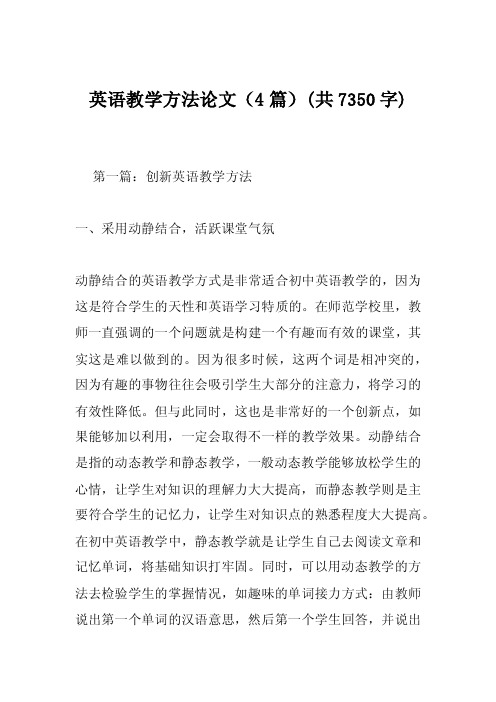
英语教学方法论文(4篇)(共7350字) 第一篇:创新英语教学方法一、采用动静结合,活跃课堂气氛动静结合的英语教学方式是非常适合初中英语教学的,因为这是符合学生的天性和英语学习特质的。
在师范学校里,教师一直强调的一个问题就是构建一个有趣而有效的课堂,其实这是难以做到的。
因为很多时候,这两个词是相冲突的,因为有趣的事物往往会吸引学生大部分的注意力,将学习的有效性降低。
但与此同时,这也是非常好的一个创新点,如果能够加以利用,一定会取得不一样的教学效果。
动静结合是指的动态教学和静态教学,一般动态教学能够放松学生的心情,让学生对知识的理解力大大提高,而静态教学则是主要符合学生的记忆力,让学生对知识点的熟悉程度大大提高。
在初中英语教学中,静态教学就是让学生自己去阅读文章和记忆单词,将基础知识打牢固。
同时,可以用动态教学的方法去检验学生的掌握情况,如趣味的单词接力方式:由教师说出第一个单词的汉语意思,然后第一个学生回答,并说出第三个单词的汉语意思,交给第二个学生回答,依此类推。
二、主攻兴趣教学,提高学习主动性兴趣是最好的学习动力,这一点是从人性的方面总结的,所以无论教学精神再怎么改变,这一点也是会一直值得肯定的。
而新时代要求的初中英语教学就不能够再像之前那样,只是用一些多彩的图画或是小游戏来吸引学生的目光,其实学生需要的往往是更大的舞台。
特别是现在的孩子们,他们在父母的栽培下往往有自己的一技之长,或是唱歌跳舞,或是书法画画,或是体育乐器,或是手工制作。
如果英语教学能够和他们本身的兴趣爱好结合起来,那么其学习效果是不可估量的。
因为学习英语就成了他们日常生活的一部分,并且是在非常愉快和不自觉的状态下完成的。
音乐的话可以是英语歌曲,体育的话可以是国外的一些比赛,甚至手工制作教师都可以给他们提供一些外国的制作步骤。
当然,教师也可以让他们自己去发现自己兴趣和英语之间存在的微妙的关系,并且作为课堂作业向其他同学展示。
三、结合时代气息,采用科技教学时代发展迅速,教育也在发生着日新月异的变化,初中英语教学就应该乘着这股东风“扶摇直上”,采用与时代科技相结合的方式去进行创新教学。
高中英语教学论文10篇完美版

高中英语教学论文10篇完美版引言本文旨在介绍十篇高中英语教学论文的完美版,这些论文涵盖了多个主题,旨在提供丰富多样的教学方法和策略,以帮助教师提高教学质量。
论文一:利用多媒体技术改善英语听说能力这篇论文探讨了如何利用多媒体技术来增强学生的英语听说能力。
论文提出了一些有效的教学策略和方法,例如使用影片、音频和互动游戏等多媒体资源。
论文二:运用情境教学法提高高中生的英语写作能力该论文研究了使用情境教学法来提高高中生英语写作能力的有效性。
论文介绍了一些实用的教学活动和案例,以帮助学生在真实场景中进行写作训练。
论文三:文化教育在高中英语课堂中的应用这篇论文讨论了文化教育在高中英语课堂中的重要性和应用。
论文介绍了一些培养学生跨文化交流能力的教学方法和实践经验。
论文四:提高高中英语听力理解的策略总结该论文总结了一些有效的策略,可帮助教师提高高中生的英语听力理解能力。
论文探讨了词汇研究、语调训练和听力材料选择等方面的教学策略。
论文五:游戏教学法在高中英语课堂中的应用这篇论文研究了游戏教学法在高中英语课堂中的应用。
论文介绍了一些以游戏为基础的教学活动和案例,以提高学生的英语研究兴趣和参与度。
论文六:利用小组探究研究提高高中英语口语表达能力该论文探讨了如何利用小组探究研究来提高高中生的英语口语表达能力。
论文介绍了小组合作研究的重要性,以及一些可行的活动和方法。
论文七:分享课堂故事以提高学生的听说能力这篇论文提到了通过分享课堂故事来提高学生的英语听说能力。
论文介绍了如何运用故事教学法和相关教学活动,激发学生的研究兴趣和提高语言表达能力。
论文八:使用影片剪辑提高高中生的英语听力水平该论文研究了使用影片剪辑来提高高中生英语听力水平的有效性。
论文介绍了如何选择合适的影片剪辑、设计相关听力任务,并给出了实施建议。
论文九:创意写作在高中英语课堂中的应用这篇论文探讨了创意写作在高中英语课堂中的应用。
论文介绍了一些创意写作的活动和方法,鼓励学生发挥想象力,提高写作质量。
英语教学实践设计论文(3篇)
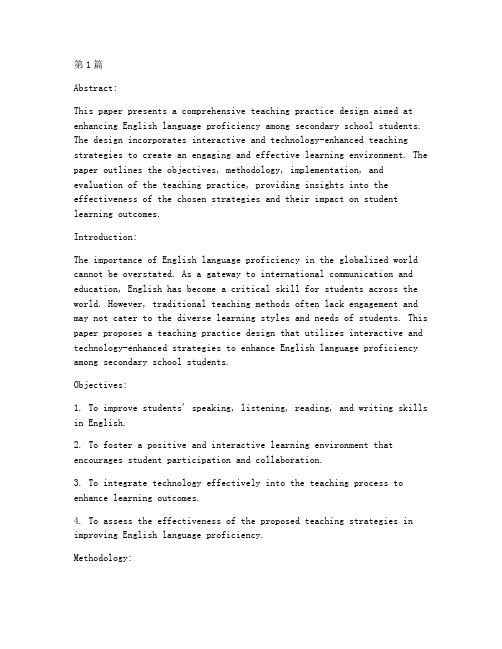
第1篇Abstract:This paper presents a comprehensive teaching practice design aimed at enhancing English language proficiency among secondary school students. The design incorporates interactive and technology-enhanced teaching strategies to create an engaging and effective learning environment. The paper outlines the objectives, methodology, implementation, and evaluation of the teaching practice, providing insights into the effectiveness of the chosen strategies and their impact on student learning outcomes.Introduction:The importance of English language proficiency in the globalized world cannot be overstated. As a gateway to international communication and education, English has become a critical skill for students across the world. However, traditional teaching methods often lack engagement and may not cater to the diverse learning styles and needs of students. This paper proposes a teaching practice design that utilizes interactive and technology-enhanced strategies to enhance English language proficiency among secondary school students.Objectives:1. To improve students' speaking, listening, reading, and writing skills in English.2. To foster a positive and interactive learning environment that encourages student participation and collaboration.3. To integrate technology effectively into the teaching process to enhance learning outcomes.4. To assess the effectiveness of the proposed teaching strategies in improving English language proficiency.Methodology:The teaching practice design is based on a mixed-methods approach, combining quantitative and qualitative data collection techniques. The following steps were followed:1. Literature Review: A thorough review of existing literature on English language teaching, interactive learning, and technology integration was conducted to inform the design of the teaching practice.2. Curriculum Analysis: The existing English language curriculum was analyzed to identify key areas that needed improvement and to align the teaching practice with the curriculum objectives.3. Strategy Selection: Based on the literature review and curriculum analysis, a set of interactive and technology-enhanced teaching strategies was selected. These included:a. Project-based Learning (PBL)b. Collaborative Learningc. Flipped Classroomd. Gamificatione. Digital Storytelling4. Implementation Plan: A detailed implementation plan was developed, outlining the sequence of activities, timelines, and resources required for the teaching practice.5. Data Collection: Both quantitative and qualitative data were collected to evaluate the effectiveness of the teaching practice. Quantitative data included pre-test and post-test scores, while qualitative data were gathered through classroom observations, student feedback, and teacher reflections.Results:The implementation of the proposed teaching practice resulted in the following outcomes:1. Improved English Language Proficiency: The post-test scores indicateda significant improvement in students' speaking, listening, reading, and writing skills compared to the pre-test scores.2. Enhanced Engagement and Collaboration: Classroom observations and student feedback revealed that the interactive and technology-enhanced strategies increased student engagement and fostered collaborative learning.3. Positive Impact on Learning Outcomes: The integration of technology into the teaching process was found to enhance learning outcomes, with students demonstrating greater enthusiasm and a deeper understanding of the subject matter.4. Teacher and Student Feedback: The feedback from teachers and students indicated a high level of satisfaction with the teaching practice, with both groups acknowledging the positive impact of the interactive and technology-enhanced strategies.Discussion:The results of the teaching practice design suggest that interactive and technology-enhanced teaching strategies can significantly enhance English language proficiency among secondary school students. The incorporation of PBL, collaborative learning, flipped classroom, gamification, and digital storytelling has led to improved engagement, collaboration, and learning outcomes.Conclusion:This paper presents a comprehensive teaching practice design thatutilizes interactive and technology-enhanced strategies to enhance English language proficiency among secondary school students. Theresults demonstrate the effectiveness of the proposed strategies in improving learning outcomes, fostering engagement, and promoting collaboration. It is recommended that educators consider incorporating similar strategies into their teaching practices to create a more engaging and effective learning environment for their students.References:1. Brown, H. D., & Yule, G. (1983). Teaching by Principles: An Interactive Approach to Language Pedagogy. New York: Prentice Hall.2. Dichev, D., & Dicheva, D. (2015). Gamification in Education: A Systematic Mapping Study. Computers & Education, 82, 124-141.3. Knezek, G., & Lai, K. (2012). Technology-Enhanced Language Learning:A Review of the Literature. Journal of Technology and Teacher Education, 20(1), 93-118.4. Puntambekar, S. S., & Puntambekar, S. A. (2008). Project-Based Learning in the Context of Language Learning. The Language Teacher,32(4), 24-29.5. Siemens, G., & Brown, J. S. (2009). Connectivism: A Learning Theory for the Digital Age. International Journal of Educational Technology in Higher Education, 6(1), 5.第2篇Abstract:This paper presents a case study of an English language teaching (ELT) practice design implemented in a secondary school in China. The study focuses on the integration of technology into the ELT curriculum to enhance student engagement, improve learning outcomes, and promote autonomous learning. The paper outlines the design of the technology-integrated ELT program, discusses the implementation process, and evaluates its effectiveness through student feedback and academic performance analysis. The findings suggest that technology integration in ELT can significantly enhance learning experiences and academic achievements.Keywords: English language teaching, technology integration, secondary education, China, autonomous learning, case study1. IntroductionIn recent years, there has been a growing emphasis on integrating technology into educational practices to cater to the evolving needs of learners and to prepare them for the digital age. The English language teaching (ELT) field is no exception, as technology offers new avenues for interactive and engaging learning experiences. This paper presents a case study of a technology-integrated ELT program implemented in a secondary school in China, aiming to explore the effectiveness of technology in enhancing English language learning.2. Literature ReviewThe literature review discusses the importance of technology integration in ELT, highlighting the benefits such as increased student engagement, improved learning outcomes, and the development of 21st-century skills. Key theories and frameworks related to technology integration in education are also presented, including constructivism, situated learning, and technology acceptance model.3. MethodologyThe case study method was employed to investigate the technology-integrated ELT program. The study involved a mixed-methods approach, including quantitative data analysis of student academic performance and qualitative data collection through interviews and surveys.4. Design of the Technology-Integrated ELT ProgramThe ELT program was designed to integrate various digital tools and resources into the curriculum, encompassing both synchronous and asynchronous learning activities. The following components were included in the program:- Interactive Whiteboards: Used for presentations, group discussions, and collaborative activities.- Educational Software: Programs such as Grammarly and Duolingo were utilized for grammar and vocabulary practice.- Online Learning Platforms: Platforms like Moodle were employed for course management, assignment submission, and peer feedback.- Mobile Applications: Apps like Anki and HelloTalk were used for vocabulary revision and language exchange.- Web-Based Resources: Websites such as BBC Learning English and TED-Ed provided authentic materials for listening, speaking, reading, and writing skills.5. Implementation ProcessThe implementation process involved several stages:- Training: Teachers received training on the use of technology tools and resources.- Curriculum Development: Teachers collaborated to integrate technology into lesson plans and activities.- Monitoring: Continuous monitoring and feedback were provided to ensure the effectiveness of the program.- Adjustments: Modifications were made based on student feedback and performance data.6. Evaluation of the ProgramThe effectiveness of the technology-integrated ELT program was evaluated through the following criteria:- Student Engagement: Surveys and interviews were conducted to assess student engagement levels.- Academic Performance: Quantitative data analysis of student academic performance was conducted.- Autonomous Learning: The development of autonomous learning skills was evaluated through self-assessment questionnaires.The findings revealed that the technology-integrated ELT program significantly enhanced student engagement and academic performance. Students reported higher levels of motivation and satisfaction with the program. Moreover, the integration of technology allowed forpersonalized learning experiences, fostering the development of autonomous learning skills.7. DiscussionThe discussion section analyzes the findings in the context of existing literature and theories. The study's strengths and limitations are addressed, and suggestions for future research are provided.8. ConclusionThis paper presents a case study of a technology-integrated ELT program implemented in a secondary school in China. The findings suggest that technology integration in ELT can significantly enhance learning experiences and academic achievements. The study highlights the importance of teacher training, curriculum development, and ongoing monitoring to ensure the effectiveness of technology integration in educational settings.References:- Alwan, A., & Hashim, R. (2016). The Impact of Technology Integration on Student Learning Outcomes in Higher Education. International Journal of Advanced Research in Management and Social Sciences, 4(2), 41-48.- Barlett, S. M., & Barlett, C. M. (2013). The Use of Technology in Language Learning. Language Learning & Technology, 17(2), 82-95.- Diduck, A. (2012). The Role of Technology in Language Learning: A Review of the Literature. Language Learning & Technology, 16(1), 2-24.- Hofer, M. K., & Paulus, T. M. (2010). The Role of Technology in Language Learning: Insights from Sociocultural Theory. Language Learning & Technology, 14(1), 32-56.- Jensen, E. (2016). Integrating Technology into Language Learning: A Case Study. Journal of Language and Linguistic Studies, 12(2), 37-50.第3篇Abstract:This paper presents a comprehensive English teaching practice design aimed at enhancing language acquisition through interactive and collaborative learning strategies. The design focuses on integrating technology, project-based learning, and communicative approaches to create a dynamic and engaging learning environment. The paper outlines the objectives, methodology, implementation, and evaluation of the teaching practice, providing insights into effective strategies for promoting language proficiency and critical thinking skills among students.Introduction:The importance of English language proficiency in the globalized world cannot be overstated. With the increasing demand for English as a medium of instruction and communication, it is crucial for educators to develop innovative teaching practices that cater to the diverse needs of learners. This paper proposes a teaching practice design that emphasizes interactive and collaborative learning, incorporating technology and project-based approaches to foster language acquisition and critical thinking skills.Objectives:1. To enhance students' listening, speaking, reading, and writing skills in English.2. To promote active engagement and participation in the classroom.3. To encourage students to think critically and solve problems using English.4. To develop students' cultural awareness and global perspectives.Methodology:The teaching practice design is based on the following methodologies:1. Interactive and Collaborative Learning: This approach involves creating a supportive and interactive learning environment where students can work together to achieve common goals. Group activities,discussions, and debates will be encouraged to promote collaborative learning.2. Technology Integration: Technology will be used as a tool to enhance learning experiences. Online platforms, educational apps, and multimedia resources will be employed to provide interactive and engaging lessons.3. Project-Based Learning: This approach involves students working on real-world projects that require them to apply their English language skills. Projects will be designed to be relevant, challenging, and motivating.4. Communicative Language Teaching: This approach focuses on communication as the primary goal of language learning. Students will be encouraged to use English in real-life situations, with emphasis on fluency and accuracy.Implementation:1. Lesson Planning: Each lesson will be carefully planned, incorporating various activities and resources to cater to different learning styles. The focus will be on creating a balance between teacher-led instruction and student-centered activities.2. Technology Integration: Online platforms like Google Classroom will be used to share resources, assign tasks, and facilitate communication between students and teachers. Educational apps such as Duolingo, Quizlet, and Kahoot! will be utilized to reinforce vocabulary and grammar concepts.3. Project-Based Learning: Students will be assigned projects that require them to research, plan, and execute tasks in English. Projects will be designed to be collaborative, allowing students to work together and share their findings with the class.4. Communicative Language Teaching: Regular discussions, debates, and role-plays will be conducted to provide students with opportunities to practice their speaking and listening skills. Feedback and corrections will be provided to encourage continuous improvement.Evaluation:1. Formative Assessment: Continuous formative assessments, such as quizzes, class discussions, and peer evaluations, will be used to monitor students' progress and identify areas for improvement.2. Summative Assessment: End-of-unit tests and project presentationswill be conducted to evaluate students' overall language proficiency and critical thinking skills.3. Self-assessment and Reflection: Students will be encouraged to engage in self-assessment and reflection, promoting self-awareness and self-regulation of their learning process.Conclusion:The proposed English teaching practice design aims to enhance language acquisition through interactive and collaborative learning strategies. By integrating technology, project-based learning, and communicative approaches, this design aims to create a dynamic and engaging learning environment that promotes language proficiency and critical thinking skills among students. The evaluation of the teaching practice will provide insights into the effectiveness of the strategies employed, allowing for continuous improvement and adaptation of the teaching methods.Keywords: English teaching practice, interactive learning, collaborative learning, technology integration, project-based learning, communicative language teaching, language acquisition, critical thinking skills.。
英语课堂教学实践论文(3篇)

第1篇Abstract:This paper explores the effectiveness of interactive classroom practices in enhancing English language acquisition. Through a case study approach, the paper examines the implementation of various interactive strategies in an English language classroom and evaluates their impact on student engagement, participation, and overall language proficiency. Thefindings suggest that interactive teaching methods not only makelearning more engaging but also contribute significantly to the development of communicative skills and critical thinking abilities among learners.Introduction:The field of English language teaching (ELT) has witnessed significant advancements in methodology over the years. One of the most notableshifts has been the move from teacher-centered to student-centered approaches, emphasizing active learning and interaction. This paper aims to investigate the effectiveness of interactive classroom practices in fostering English language acquisition. By analyzing a case study of an English language classroom, this paper will provide insights into how interactive strategies can be implemented to enhance student learning outcomes.Literature Review:Interactive teaching methods have been widely studied in the field of ELT. Research indicates that such methods can lead to improved student engagement, participation, and language proficiency (Harmer, 2007; Nunan, 1991). Some common interactive strategies include pair work, group work, role-playing, and task-based learning (Ellis, 1994). These strategies encourage students to interact with each other and the teacher, thereby promoting the development of communicative skills and critical thinking abilities.Case Study:The case study presented in this paper involves an English language classroom at a secondary school in a suburban area. The classroom consists of 30 students aged 14-16, with varying levels of English proficiency. The case study focuses on the implementation of interactive teaching strategies over a period of eight weeks.Methodology:The data for this case study were collected through classroom observations, student interviews, and the analysis of students' written assignments. The observations were conducted using a checklist to record the frequency and effectiveness of interactive teaching strategies. The interviews with students aimed to gather their perspectives on the interactive methods used in the classroom. The written assignments were analyzed to assess the students' language proficiency and engagement with the learning tasks.Interactive Teaching Strategies Used:1. Pair Work: Students were frequently assigned tasks that required them to work in pairs, such as discussing topics, completing exercises, or preparing presentations. This strategy encouraged students to practice their speaking and listening skills in a supportive environment.2. Group Work: Group activities were designed to foster collaboration and critical thinking. Students were divided into small groups to work on projects, solve problems, or engage in debates.3. Role-Playing: This strategy was used to simulate real-life situations and encourage students to practice their speaking and listening skills. Role-playing activities were particularly effective in developing students' fluency and confidence.4. Task-Based Learning: Students were engaged in various tasks, such as writing emails, creating posters, or designing advertisements. These tasks were designed to be relevant to their lives and required them to use a range of language skills.5. Questioning Techniques: The teacher employed various questioning techniques to promote student participation and encourage deeper thinking. This included open-ended questions, higher-order thinking questions, and questions that required students to explain their reasoning.Findings:The findings of the case study indicate that the implementation of interactive teaching strategies had a positive impact on the students' language acquisition and engagement. The following points highlight the key findings:1. Increased Participation: Students reported higher levels of participation in the classroom, with more students actively engaging in discussions and activities.2. Improved Language Proficiency: The analysis of written assignments showed that students' language proficiency improved significantly, with better grammar, vocabulary, and sentence structure.3. Enhanced Communication Skills: The interactive nature of the classroom encouraged students to practice their speaking and listening skills, leading to improved communicative abilities.4. Critical Thinking: The use of group work and task-based learning activities helped students develop critical thinking skills, as they were required to analyze information, solve problems, and make decisions.Conclusion:The case study presented in this paper demonstrates the effectiveness of interactive teaching methods in enhancing English language acquisition. By incorporating various interactive strategies, teachers can create a more engaging and effective learning environment that promotes student participation, critical thinking, and overall language proficiency. Itis recommended that teachers continue to explore and implement interactive teaching strategies to improve the quality of English language instruction.References:Ellis, R. (1994). The Study of Second Language Acquisition. Oxford: Oxford University Press.Harmer, J. (2007). The Practice of English Language Teaching. Essex: Pearson Education Limited.Nunan, D. (1991). Language Teaching Methodology: A Textbook for Teachers. New York: Prentice Hall International.第2篇Abstract:This paper explores the effectiveness of interactive classroom practices in English language teaching. By analyzing various interactivetechniques and their impact on student engagement and language acquisition, the study aims to provide insights into how educators can create a dynamic and engaging learning environment. The paper discusses the theoretical framework underpinning interactive teaching, presents a case study of an English language classroom, and concludes with recommendations for educators to incorporate interactive practices into their teaching methodology.Introduction:The significance of English language teaching cannot be overstated in today's globalized world. As English continues to be the lingua franca, the ability to communicate effectively in English has become crucial for personal and professional development. Traditional teaching methods, often centered around teacher-centered lectures and rote memorization, have been criticized for their lack of engagement and limited effectiveness in fostering language acquisition. This paper proposesthat interactive classroom practices can significantly enhance English language teaching by promoting student participation, encouraging active learning, and fostering a supportive learning community.Theoretical Framework:Interactive teaching is grounded in constructivist learning theory, which posits that knowledge is constructed through the interaction between learners and their environment. According to this theory, learners are active participants in their own learning process, andtheir understanding of new concepts is enhanced through collaboration, discussion, and problem-solving activities. Some key principles of interactive teaching include:1. Student-centered learning: Emphasizing student participation and responsibility for their learning.2. Collaborative learning: Encouraging students to work together in groups to achieve common goals.3. Active learning: Promoting engagement through hands-on activities, discussions, and problem-solving tasks.4. Authentic communication: Providing real-life contexts for language use and encouraging meaningful communication.Case Study: An Interactive English Language ClassroomFor the purpose of this study, a case study was conducted in an English language classroom at a secondary school in China. The classroom setting consisted of 30 students aged 15-16, and the study focused on the implementation of interactive teaching practices over a period of six weeks.The interactive teaching practices employed in this study included:1. Pair and group work: Students were divided into pairs or small groups to complete tasks and discuss topics related to the curriculum.2. Role-playing and simulations: Students were encouraged to engage in role-plays and simulations to practice language in realistic contexts.3. Question and answer sessions: Regularly asking students questions to promote critical thinking and encourage them to express their opinions.4. Project-based learning: Assigning projects that required students to work collaboratively and use their English language skills in various contexts.Results:The results of the case study indicated that interactive teaching practices had a positive impact on the students' engagement and language acquisition. Students reported increased motivation, improved confidence in their language abilities, and a greater understanding of the material. Observations and assessments also showed that students were more likely to participate in class discussions, collaborate with their peers, and demonstrate higher levels of critical thinking.Discussion:The findings of this study support the notion that interactive teaching practices can significantly enhance English language teaching. By promoting student participation, interactive methods encourage learners to become active and responsible for their own learning. This active engagement is essential for the development of communicative competence, which is the ultimate goal of language learning.However, it is important to note that the successful implementation of interactive teaching practices requires careful planning and preparation. Educators must be familiar with various interactive techniques and be willing to adapt their teaching methods to suit the needs of their students. Additionally, creating a supportive and inclusive learning environment is crucial for the success of interactive teaching.Conclusion:In conclusion, this paper has demonstrated the effectiveness of interactive teaching practices in English language teaching. By incorporating interactive methods into their teaching methodology, educators can create a dynamic and engaging learning environment that fosters student participation, encourages active learning, and enhances language acquisition. Further research is needed to explore the long-term impact of interactive teaching practices on language learning outcomes and to develop best practices for their implementation.Recommendations:Based on the findings of this study, the following recommendations are made for educators and institutions involved in English language teaching:1. Educators should be trained in interactive teaching methods and encouraged to incorporate these practices into their teaching.2. Schools should provide resources and support for educators to implement interactive teaching practices effectively.3. Assessment methods should be designed to measure the impact of interactive teaching on language learning outcomes.4. Continuous professional development opportunities should be provided for educators to stay updated with the latest trends and best practices in interactive teaching.By adopting these recommendations, educators can create a more effective and engaging English language learning experience for their students.第3篇Abstract:This paper aims to explore the effectiveness of interactive and student-centered approaches in English language classroom practice. Through a case study of a semester-long English course, the paper analyzes the implementation of various teaching strategies and their impact on student engagement, learning outcomes, and overall language proficiency. The findings suggest that incorporating interactive and student-centered activities significantly enhances the learning experience and promotes active participation, critical thinking, and autonomous learning among students.Introduction:The field of English language teaching (ELT) has witnessed significant changes over the years, with an increasing emphasis on student-centered approaches and interactive learning activities. These methodologies are believed to foster a more engaging and effective learning environment, where students are actively involved in the learning process. This paper presents a case study of an English language course that implemented interactive and student-centered strategies to assess their impact on student learning and language proficiency.Methodology:The study involved a semester-long English course for undergraduate students at a university in China. The course consisted of 15 weeks, with each week dedicated to a specific theme or skill area. The study adopted a qualitative approach, involving observations, interviews, and analysis of students' written work and performance in class.Data Collection:The data collection methods included:1. Classroom observations: The researcher observed each class session, noting the teacher's interaction with students, the types of activities used, and the overall atmosphere of the classroom.2. Interviews: Semi-structured interviews were conducted with the teacher and a random sample of 10 students to gather insights into their perceptions and experiences of the course.3. Students' written work and performance: The researcher collected and analyzed students' written assignments, quizzes, and in-class responses to evaluate their language proficiency and engagement with the course material.Data Analysis:The collected data were analyzed thematically, focusing on the following aspects:1. Teacher-student interaction: The frequency and nature of teacher-student interaction during class sessions.2. Student engagement: The level of participation, enthusiasm, and critical thinking demonstrated by students.3. Learning outcomes: The progress made by students in terms of language proficiency, vocabulary acquisition, and understanding of the course themes.Results:The findings of the study revealed several key points regarding the implementation of interactive and student-centered approaches in the English language classroom:1. Teacher-student interaction: The teacher actively engaged with students through questioning, feedback, and encouragement, promoting a more dynamic and responsive classroom environment. This interaction was crucial in maintaining student interest and facilitating deeper understanding of the material.2. Student engagement: The interactive and student-centered activities encouraged students to actively participate in class discussions, group work, and individual projects. This engagement was evident in their enthusiasm, critical thinking, and willingness to take risks in their language use.3. Learning outcomes: The implementation of these strategies resulted in significant improvements in students' language proficiency, vocabulary acquisition, and overall understanding of the course themes. Students demonstrated enhanced reading, writing, listening, and speaking skills, as well as a greater ability to apply the language in real-life contexts.Discussion:The findings of this study support the effectiveness of interactive and student-centered approaches in English language classroom practice. These methodologies promote a more engaging and effective learning environment, where students are actively involved in the learningprocess. The following points highlight the key contributions of these approaches:1. Increased student participation: Interactive activities encourage students to engage with the material, share their thoughts, and collaborate with peers, leading to a more dynamic and inclusive classroom environment.2. Enhanced critical thinking: Student-centered approaches promote critical thinking and problem-solving skills by allowing students to explore topics from multiple perspectives and develop their own opinions.3. Autonomous learning: Interactive and student-centered activities encourage students to take responsibility for their learning, fostering a sense of autonomy and independence.Conclusion:In conclusion, this study demonstrates the positive impact ofinteractive and student-centered approaches on English language classroom practice. By incorporating these strategies, teachers can create a more engaging and effective learning environment, promoting active participation, critical thinking, and autonomous learning among students. Further research is needed to explore the long-term effects of these methodologies on students' language proficiency and overall academic success.。
《英语课堂教学教案设计毕业论文》

英语课堂教学教案设计毕业论文引言英语课堂教学教案设计是教育学专业毕业生撰写的一种重要论文,通过对教案设计的研究和实践,毕业生能够深入了解教学理论和实践,并能够应用这些知识进行课堂教学。
本文将介绍英语课堂教学教案设计的重要性、研究背景和目的,并提供一些有效的教案设计方法和实施步骤。
1. 为什么需要英语课堂教学教案设计?英语课堂教学教案设计是教师在进行教学活动时所制定的计划和安排,它对于教师来说具有重要的指导作用。
教案设计有助于达到以下几个目的:•促进教师的教学准备。
教案设计要求教师在课前充分准备,包括教学目标、教学内容、教学方法、教学资源等方面的准备工作。
这有助于教师更好地组织课堂教学,提高教学质量。
•提高教学效果。
通过教案设计,教师能够合理地组织课堂教学活动,使学生能够主动参与、全面发展。
教案设计还能够帮助教师灵活运用不同的教学方法和手段,提高学生的学习兴趣和效果。
•调整教学内容和方法。
教案设计能够帮助教师根据学生的实际情况进行教学内容和教学方法的选择和调整。
这有助于教师更好地适应学生的学习需求,提高教学效果。
2. 英语课堂教学教案设计的研究背景和目的英语课堂教学教案设计的研究背景主要有以下几个方面:•语言教学理论的发展。
随着语言教学理论的不断发展,教师对英语课堂教学教案设计也有了更深入的研究和理解。
语言教学理论为教案设计提供了理论依据和指导。
•教学实践的需要。
实践是检验理论的重要手段,英语课堂教学教案设计也需要通过实践和反思来不断完善和改进。
因此,对英语课堂教学教案设计的研究就显得尤为重要。
•教师自身需要。
英语教师需要通过教案设计来提高自身的教学能力和水平,适应不同学生的学习需求,并持续提升自己的专业发展。
本文的研究目的主要有以下几点:•探讨英语课堂教学教案设计的重要性及其指导作用。
•分析并总结有效的教案设计方法和实施步骤。
•提出一些改进教案设计的建议和策略。
3. 英语课堂教学教案设计的方法和步骤3.1 教案设计的方法教案设计需要根据不同的教学目标和教学内容选择合适的方法。
专业英语课堂教学设计的论文

专业英语课堂教学设计的论文专业英语课堂教学设计的论文一、专业英语课堂教学设计的基本内容课堂教学设计一般包括下列几个基本内容:分析教学内容、分析教学对象、阐明教学目标、制定教学策略、建构教学过程以及进行教学评价。
1.分析教学内容教学内容是教学过程中所需要完成的教学任务。
一般情况下,分析教学内容必须先理清、确定知识点,技校专业英语的知识点一般分布在专业术语识记、文章阅读、语言表达等方面。
接着,从知识点中分析、确定教学的重难点,其中应特别考虑学生对专业英语的应用。
最后是对教材进行加工,根据社会发展动态、学生特点,根据教材存在的难、繁、旧、乏味、实用性不强等问题,对教材进行取舍、补充、简化、加工,实现课堂教学最优化第一步。
2.分析教学对象学生是课堂教学的主体,对学生进行分析是为了了解学生目前所达到的水平及存在的问题,以更好地帮助他们解决学习中的困难,最终顺利高效地完成教学任务。
在教学任务开始前教师做到以下两点,就是对课堂教学设计做好了从实际出发的准备:(1)分析学生认知、技能、情感态度等方面的水平,掌握这个初始能力,才不至于使所设计的课堂教学偏离学生实际,导致课堂教学设计无法顺利实施。
(2)对主体进行层次分析。
层次分析的目的在于预防整个课堂教学设计出现片面性。
3.阐明教学目标课堂教学目标是指教学活动预期达到的结果,是教育目的、教学目标和课程目标的具体化,也是教师完成教学任务所要达到的要求和标准。
对专业英语课堂教学目标的理解与设计应该注意以下两个方面。
(1)教学目标的分类。
美国当代著名的教育家和心理学家本杰明布卢姆将教学目标分成认知领域、情感领域及动作技能领域三大类。
专业英语教学也应该学习基础教育从维度出发,确立“知识与技能、过程与方法、情感态度与价值观”的“三维目标”。
(2)教学目标的编写。
目前,大多数技校专业英语教师对教学目标的编写停留在模仿水平。
依据《现代教育技术教程》笔者编写了专业英语教学目标的例子加以说明:例:通过小组讨论,学生能迅速准确地翻译出句子意思。
- 1、下载文档前请自行甄别文档内容的完整性,平台不提供额外的编辑、内容补充、找答案等附加服务。
- 2、"仅部分预览"的文档,不可在线预览部分如存在完整性等问题,可反馈申请退款(可完整预览的文档不适用该条件!)。
- 3、如文档侵犯您的权益,请联系客服反馈,我们会尽快为您处理(人工客服工作时间:9:00-18:30)。
浅谈英语课堂教学设计
摘要现代化英语教学中,各种现代教学手段的介入,如:挂图、多媒体教室、投影仪等传统意义的黑板已经不能满足课堂需要了。
高科技的投入可使学生通过鲜艳的色彩、活动的图像和有声的对话,产生一种赏心悦目的感觉,营造了愉悦学习氛围。
但是,它不能带给学生实际的功效,产生愉悦的同时也会产生依赖。
何况在许多的地方还没有普及,所以黑板的作用在目前来说还占有十分重要的地位。
英语是一种情境很强的学科,光有教师讲,靠黑板白字是难以引起学生兴趣的。
在这种新老教学手段更替的时期,如何很好地进行课堂教学设计使得黑板的内涵更加丰富是摆在我们一
线教师迫切任务。
关键词课堂教学设计现代教学手段多媒体
现在的学生个性审美观念很强,用传统的黑板进行设计整个课堂教学,显得形式单一,枯燥乏味。
不符合当代教育理念。
我提倡现代教学设计就是要一改这一单一模式,在原有的基础上加上一些符合学生美感的背景图片资料,使之图文并茂,丰富板书的内容;形式上适当利用多媒体进行背景教学,重要的地方要凸显出来,可使用彩色粉笔,引起学生注意的同时充实板书的色彩。
课前备课时,认真钻研课本,精心设计课堂中的板书,对所需板书的词、字、句都必须胸有成竹。
在每课具体的设计中,注意充分发挥各要素的互补作用。
一、利用网络的信息量进行背景教学,实现教学内容的导入设
计
比如在教学the green hills of tangsa一课时,教师可以放映一些紧扣教学的短片,诸如:why did the people along the changjiang river suffer a lot in the big flood in 1998?动物保护问题——the secret is out;关注地球问题——saving the earth;残疾人问题——feed the world;垃圾处理问题——dealing with waste 及自然灾害问题——earthquake, fire, hurricane 等让学生接受知识的同时增强责任感。
二、利用计算机,制作精美的课件,把好课堂教学设计关
譬如我在讲《unit 5 if you go to the party , you’ll have a great tim!》时设计一群小伙子们在开party,孩子在愉快地交流和合作的短片,一下就把学生学习热情调起来了,因为这一课的影响,许多同学在庆祝生日时也开起了自己的小party。
另外,我让全班同学分成六组,设计教学情景,把重点的词、句进行口语交流与举例比赛。
如:
are you going to the party ?
yes , i am . i’m going to wear my jeans.
if you do , you’ll have a great time .
you should wear your cool pants .等。
同学们热情高涨,从而使每个学生都在轻松愉快中学到这一课堂应该掌握的词汇和句型,通过学生自己生动形象活泼的表演使学生身临其境的学习英语。
这样的课堂教学设计可获得事半功倍的效果。
三、巧妙利用教学道具,为备好的课件锦上添花
(一)用好每一课挂图
挂图往往是内容的开端又是课文的重点。
每篇课文中都会有配套的挂图,它们都是现成的,我们可以把它作为课堂教学的一部分来利用,根据挂图提出的问题,用直观来引起他们的兴趣,为一堂课的开始开个好头。
以初中第二册(下)第七十七课为例,可以设计这样几个问题:1)what are they doing?(他们在干什么?);2).why are they cooking?(他们为什么烧饭?);3)what are they going to cook?(他们打算烧什么?)
(二)利用黑板和粉笔进行优美整洁的板书设计
黑板和粉笔功效比较传统,但通过黑板和粉笔可以将本单元的重点难点及知识的脉络理清楚。
四、重视课堂教学的作业设计,确保每堂课教学能使效果最优化
好的课堂教学的作业设计我认为必须满足三个条件:一是要针对性,切忌盲目重复;二要有系统性,切莫在单一知识点上敷衍了事;三要有开放性,让学生进行交流与合作题型应该监督其实施。
实践才能出真知。
我以初中第二册(下)第七十七课为例,在此展示我的课堂教学设计,具体如下:
(一)利用电脑和投影仪呈现一个美丽庄园背景。
介绍“this is a farm.(这是一个农场。
),接着进行师生对话:“what’s this?”。
“it’s ......”。
这是一个比较简单的问题,
可以问基础较差的学生,让他们感觉到自己的存在,增加其自信心,并可调动全体学生的积极性。
这样就非常顺利地拉开了教学的帷幕。
(二)教师用预先备好一只小胖猪挂图。
问:“what’ this?”。
带读“the meat of it is pork.”。
写出“pork”单词在旁边。
然后进行正常教学这个单词。
接着展示“cabbage(卷心菜)”、“carrot(胡萝卜)”、“tomato(西红柿)”等蔬菜的挂图,同时与学生交流:“it likes eating vegetables.”此时还可以把准备好的小图片或实物都拿出给学生们看,让学生熟悉单词,并能让他们跟实物对上号,日常生活中如果他们再看到此物就会又联想起这单词来,这样学生才会轻松掌握。
(三)引导学生提出重点。
充分调动学生的参与意识,请学生自己结合所学知识,利用挂图内容,进行一些“情形对话”,“who is living here? ann is living her with her family. what’re they doing?。
(四)布置作业。
让同学写一篇介绍自己qq开心农场,及在农场中种的果蔬的英文名称。
整堂课下来,设计的集整体性、艺术性和趣味性于一体,情境结合,大大改善了课堂气氛,提高了学习效率。
总之,课堂教学设计好坏直接影响你的教学质量。
优质的课堂教学设计受各种条件的制约,但我们不能说条件不好就不需要精心
设计课堂教学,我们可以利用我们的智慧去创造条件让学生愉快地接受知识,快乐成长。
参考文献:
[1]《浅谈如何利用多媒体上英语课》,教育论文网,2002,3
[2]《英语周报》初中版,山西师范大学出版,2007,9
[3]《走遍美国》vcd,北京音响出版发行,2006,6
[4]《走进英语教学新领域对脑图英语教学现象的思考》教育论文网点,2009,7。
